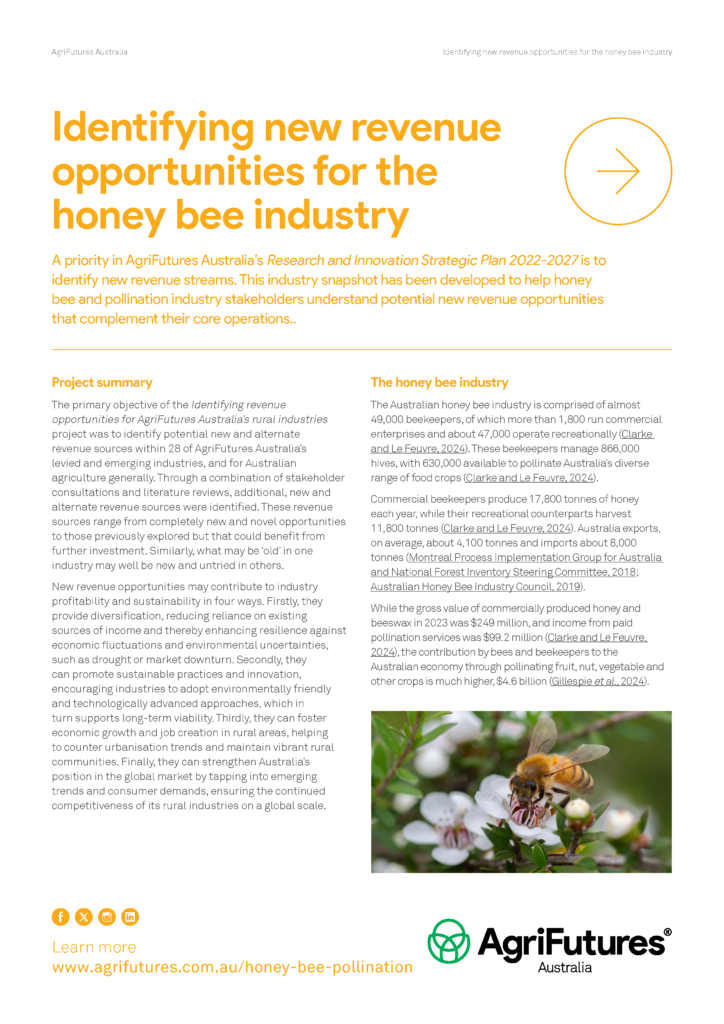Determining the impact of Varroa on virus transmission in Australian bees
This research aimed to contribute to ongoing surveillance of the Australian honey bee virus landscape as varroa establishes and spreads.
 HONEY BEE & POLLINATION
HONEY BEE & POLLINATION 
2 pages
Published: 11 Oct 2024
Author(s): AgriFutures Australia
Download report PDF
DownloadThe primary objective of the Identifying revenue opportunities for AgriFutures Australia’s rural industries project was to identify potential new and alternate revenue sources within 28 of AgriFutures Australia’s levied and emerging industries, and for Australian agriculture generally. Through a combination of stakeholder consultations and literature reviews, additional, new and alternate revenue sources were identified. These revenue sources range from completely new and novel opportunities to those previously explored but that could benefit from further investment. Similarly, what may be ‘old’ in one industry may well be new and untried in others.
New revenue opportunities may contribute to industry profitability and sustainability in four ways. Firstly, they provide diversification, reducing reliance on existing sources of income and thereby enhancing resilience against economic fluctuations and environmental uncertainties, such as drought or market downturn. Secondly, they can promote sustainable practices and innovation, encouraging industries to adopt environmentally friendly and technologically advanced approaches, which in turn supports long-term viability. Thirdly, they can foster economic growth and job creation in rural areas, helping to counter urbanisation trends and maintain vibrant rural communities. Finally, they can strengthen Australia’s position in the global market by tapping into emerging trends and consumer demands, ensuring the continued competitiveness of its rural industries on a global scale.
Industry-specific challenges
Specific insights relating to the Australian honey bee industry include:
1. Varroa mite is now considered endemic in Australia, and the industry has transitioned to managing, rather than attempting to eradicate, the pest. This will impact honey production, exacerbate pressure on beekeepers to pollinate food crops, and redirect resources away from other research and development activities.
2. Overall honey production per hive has reduced over time. The number of beekeepers has exponentially increased in the past few decades, but honey production has remained relatively constant.
3. Levy leakage – 21,800 tonnes of honey produced both commercially and recreationally is not levied and represents more than half the amount of the levied quantity. This significantly impacts the capacity and quality of research into challenges and opportunities in the honey bee and pollination industries.
Industry-specific opportunities
Specific opportunities relating to the Australian honey bee industry include:
1. Investing in the development of the pollination services sector. The pollination services sector is near capacity, with the almond industry hiring about 227,000 hives annually. Australia’s feral bee population is declining due to land use changes, which is also resulting in increased demand for pollination services.
2. Articulating and exploiting the health benefits of honey through clear differentiation between authentic Australian honey and adulterated or mislabelled products, and research into substantiating the health claims through demonstratable evidence.
3. Product development from honey bee by-products, such as beeswax, pollen, propolis, royal jelly and bee venom.